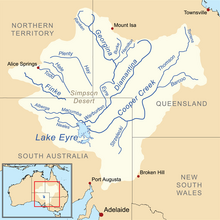Cooper Creek
Cooper Creek (formerly Cooper's Creek) is one of the most famous rivers in Australia. It is sometimes called the Barcoo River after one of its tributaries. It is one of three major Queensland river systems that flow into Lake Eyre. The water flow in Cooper Creek comes from monsoonal rains falling months earlier and many hundreds of kilometres away in eastern Queensland.[1] At 1,300 kilometres (810 miles) in length, it is the second longest inland river system in Australia after the Murray-Darling system.[1]
| Cooper Cooper's | |
|---|---|
 Cooper Creek Crossing at Innamincka, South Australia | |
 Map of the Lake Eyre Basin showing Cooper Creek | |
| Etymology | Charles Cooper[1] |
| Location | |
| Country | Australia |
| State | Queensland, South Australia |
| Region | Channel Country |
| City | Innamincka |
| Physical characteristics | |
| Source | |
| - elevation | 140 m (460 ft) |
| Mouth | |
| - location | Lake Eyre, Far North, South Australia |
| - coordinates | (28°23′S 137°41′E / 28.383°S 137.683°E) |
| - elevation | 5 m (16 ft) |
| Length | 1,300 km (810 mi) |
| Basin features | |
| River system | Lake Eyre basin |
| Tributaries | |
| - left | Thomson River, Wilson River |
| - right | Barcoo River |
| [2] | |
History
changeCharles Sturt named the river in 1845 after Charles Cooper, the Chief Justice of South Australia.[1] The explorers Burke and Wills died from starvation in 1861 on the banks of Cooper Creek. John King survived the expedition with help from the Aborigines. Only ten years after the explorers' deaths, homesteads were being built along the creek. A station (farm) at Innamincka was the first permanent settlement in the area.[1]
By 1880 the reliable water source had attracted many settlers. The whole area was taken up and stocked with cattle.[1] This pushed the local Aborigines from their traditional lands. By 1900 their population was just 30, only 10% of the original number, as influenza and measles took their toll.[1]
Course
changeThe creek starts west of the Great Dividing Range as two rivers, the Thomson from near Longreach and Charters Towers, and the Barcoo in the area around Barcaldine, about 500 kilometres (310 miles) inland from Rockhampton.
Cooper Creek spreads out into a vast area of channels, making its way south into the far south-west corner of Queensland before turning west into South Australia towards Lake Eyre. In most years, the water soaks into the earth, fills channels and waterholes, or simply evaporates without reaching Lake Eyre. In very wet years, however, it can flood the entire Channel Country and reach Lake Eyre after flowing through the Strzelecki Desert, Sturt Stony Desert and the Tirari Desert.[3] Although the Cooper carries much more water than the Diamantina and the Georgina, it does not flow into Lake Eyre as often as those rivers. One reason is that much more water is lost than with the Diamantina or Georgina. During a flood Cooper Creek may be as wide as 40 kilometres (25 miles).[3]
Land use
changeMost of the land around the Cooper is used for sheep and cattle grazing on natural grasslands. The rainfall is not reliable enough to grow crops. The soils are quite fertile, though generally heavy in texture and often crack when they dry out.
Related pages
changeReferences
change- ↑ 1.0 1.1 1.2 1.3 1.4 1.5 1.6 Reardon, Mitch (1995). The Australian Geographic Book of Corner Country. Terrey Hills, New South Wales: Australian Geographic. pp. 91–108. ISBN 1862760128.
- ↑ "Map of Cooper Creek". Bonzle Digital of Australia. Retrieved 25 March 2017.
- ↑ 3.0 3.1 "Flood Warning System for the Thompson & Barcoo Rivers & Cooper Creek". Bureau of Meteorology (Australia). Retrieved 2009-10-19.
Other websites
change- Aerial Video of the Cooper Creek at Innamincka
- Australian Society for Limnology Archived 2006-01-03 at the Wayback Machine
- Primary Industries and Resources SA - Cooper and Diamantina Archived 2005-07-17 at the Wayback Machine
- Floods of Lake Eyre Archived 2006-03-12 at the Wayback Machine
- Gerald Nanson Channel Country Archived 2005-07-21 at the Wayback Machine
- Department of the Environment and Heritage Archived 2005-07-18 at the Wayback Machine